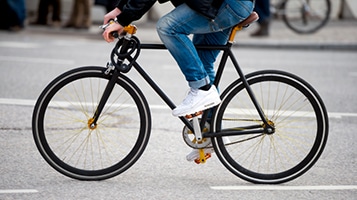Bicycle Safety
Bicycle trips make up only 1% of all trips in the United States.1 However, bicyclists account for over 2% of people who die in a crash involving a motor vehicle on our nation’s roads.2-3
Note that bicycle refers to bicyclists and other cyclists including riders of two-wheel, nonmotorized vehicles, tricycles, and unicycles powered only by pedals.

Deaths and Injuries
Nearly 1,000 bicyclists die and over 130,000 are injured in crashes that occur on roads in the United States every year.3
Cost
The costs of bicycle injuries and deaths from crashes typically exceed $23 billion in the United States each year.3 These costs include spending on health care and lost work productivity, as well as estimated costs for lost quality of life and lives lost.
Risks vary by age and sex
- Adults ages 55-69 have the highest bicycle death rates.3
- Adolescents, teens, and young adults have the highest rates of bicycle-related injuries treated in emergency departments (EDs). People ages 10-24 account for nearly one-third of all bicycle-related injuries seen in US EDs.3
- Male bicyclists have death rates 6 times higher and injury rates 5 times higher than females.3
Additional risk factors
- Most bicyclist deaths occur in urban areas.2
- About 64% of bicyclist deaths occur on sections of roads away from intersections (where higher speeds might occur) and 27% occur at intersections.2
- About one-third of crashes that result in a bicyclist’s death involve alcohol for the motor vehicle driver and/or bicyclist.2
Effective Interventions
Effective interventions to reduce injuries and fatalities to bicyclists include the following:
- Bicycle helmets
- Bicycle helmets reduce the risk of head and brain injuries in the event of a crash.4-6 All bicyclists, regardless of age, can help protect themselves by wearing properly fitted bicycle helmets every time they ride.
- Bicycle helmet laws
- Bicycle helmet laws are effective for increasing helmet use and reducing crash-related injuries and deaths among children and adults.7
Promising Interventions
Interventions that have shown promise for reducing injuries and fatalities to bicyclists include rider visibility and active lighting. For example:
- Fluorescent clothing can make bicyclists visible from further away than regular clothing during the daytime.7
- Retro-reflective clothing and materials on the bicycle can make bicyclists more visible at night.7
- Active lighting may improve the visibility of bicyclists and is required by law in most states when bicycles are ridden after dark.7 Active lighting includes front white lights, rear red lights, or other lighting on the bicycle or bicyclist.
Information about roadway engineering measures, like bike lanes, that can improve safety for bicyclists is available from the Federal Highway Administration and The Pedestrian and Bicycle Information Center.
- Federal Highway Administration. 2017 National Household Travel Survey. Washington, DC: US Department of Transportation; 2017. Available at: https://nhts.ornl.gov/person-trips. Accessed on 03/15/2022.
- National Highway Traffic Safety Administration. Traffic Safety Facts, 2019 data – bicyclists and other cyclists. Washington, DC: US Department of Transportation; 2021. (Publication no. DOT HS 813 197).
- Centers for Disease Control and Prevention. Web-based Injury Statistics Query and Reporting System (WISQARS). Atlanta, GA: Centers for Disease Control and Prevention, National Center for Injury Prevention and Control. Available at cdc.gov/injury/wisqars. Accessed on 03/15/2022.
- Hoye A. Bicycle helmets – to wear or not to wear? A meta-analyses of the effects of bicycle helmets on injuries. Accid Anal Prev 2018;117:85-97.
- Olivier J, Creighton P. Bicycle injuries and helmet use: a systematic review and meta-analysis. Int J Epidemiol 2017;46:278-292.
- Strotmeyer SJ, Behr C, Fabio A, Gaines BA. Bike helmets prevent pediatric head injury in serious bicycle crashes with motor vehicles. Int J Epidemiol 2020;7(Suppl 1):24.
- National Highway Traffic Safety Administration. Countermeasures that work: A highway safety countermeasures guide for State Highway Safety Offices, 10th edition. [PDF – 641 pages] (Report No. DOT HS 813 097). Washington, DC: National Highway Traffic Safety Administration. 2021.